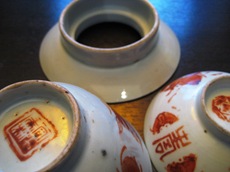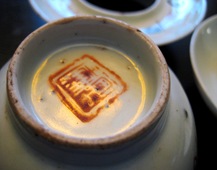The latest piece in my collection is a mid-late Qing dynasty gaiwan. The collector I bought it from dates it to the late-1800s. I was most interested in figuring out how this piece - the shape, materials, processing - would affect my tea brewing.
The person that I bought the piece from theorized that it would be best used for high-fire oolongs, helping to soften the brew. I tried the tea on a phoenix dancong and a green puerh before buying and thought the vessel good enough to purchase for additional testing.
The piece is more rice-bowl shaped than modern gaiwans. Back in the day, these types of gaiwan weren't used for brewing tea as we do today. Tea leaves were placed in the bowl, hot water was poured in, and one would sip from the bowl, using the lid to push away the leaves. Some teahouses and restaurants in Asia still serve their customers tea this way (more for novelty than for function).
Hand painted peach blossoms on the gaiwan and stylized characters on the holder. The material is a coarse porcelain, light gray, with flecks of minerals from hand-pulverized clay. Wood-kiln fired with bits of ash that stuck to the piece.
The lid doesn't fit perfectly onto the piece either, which is typical of many antique gaiwan. This was probably a mid-grade piece for that time. A higher-quality mid-Qing gaiwan is on my wish-list. That has more ornate decorations, higher-quality porcelain and a higher-standard of craftsmanship (and an exorbitant price to match!).
There are gaps between the lid and bowl due to it imperfect roundness. The wide-bowl shape aids in cooling the temperature of brewing tea. Lastly, the coarse porcelain is more porous than the modern stuff that is pulverized to a mash-like substance before shaping, which would further provide temperature-cooling properties, as well as affect the body and mouth feel of brewed tea.
I ran several tests with this piece against my modern gaiwans and even my wood-fired gaiwan from the 1980s and found that this gaiwan didn't brew higher-oxidized or higher-roasted oolongs as well. The attributes of this gaiwan are in opposition to a good yixing pot, which I think is the best brewing vessel for a highly-oxidized, high-fired oolong. Tieguanyin and Wuyi Yancha tasted bland with this gaiwan, as if their flavors weren't being released. However, light oolongs like Baozhong and Alishan turned out quite nicely. The floral notes were well balanced and the brew was smooth and light with a uniform hui gan. Green teas (Long Jing and Sencha) also turned out very well, superior to all other brewing vessels I have.












I've learned to like reading about different vessels for drinking tea. Therefore I enjoyed this post. It's good to see reviews of how different teas taste in the different cups too. I'll go for the Yi Xing, personally, for the Wuyi teas and also that green Pu-erh. --Teaternity
ReplyDeleteAgreed, I too find a clay pot best for high-fire oolongs. I am undecided on puerhs. But good, old porcelain can have a special effect on the atringency of some teas. This one, unfortunately, may soften but also cools too much, producing an uneven high-fire oolong brew.
ReplyDelete